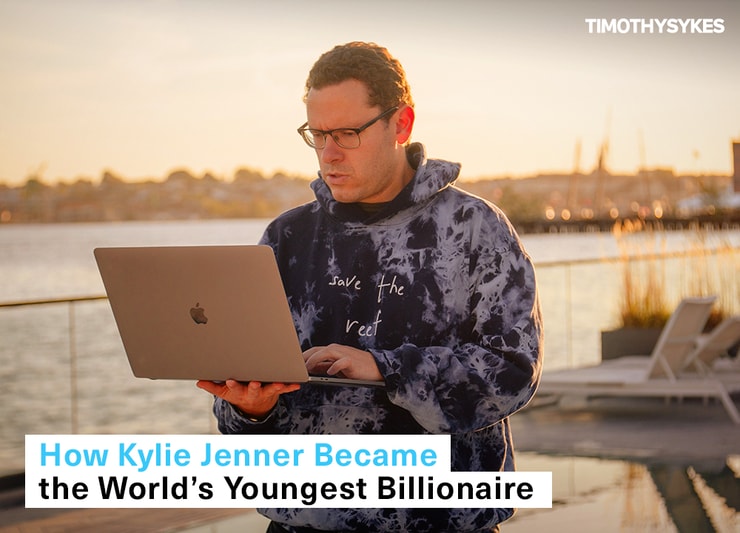Table of Contents
- 1 [Update May 29, 2020] Kylie Jenner Is No Longer a Billionaire
- 2 How Kylie Jenner Became the World’s Youngest Billionaire at 21
- 3 What Does Self-Made Billionaire Mean?
- 4 How Kylie Jenner Built Her Business
- 5 Other Companies Built on Social Media Influence
- 6 Get Ready for My Next Research Report
[Update May 29, 2020] Kylie Jenner Is No Longer a Billionaire
This post was published on Jan 10, 2020. At the time, I believed Kylie was the world’s youngest billionaire.
Now it appears the moniker was premature. In a new bombshell article, Forbes alleges Kylie lied to inflate her company’s numbers. There’s even a suggestion of faked tax returns. This video by the article’s authors explains why Kylie Jenner is no longer a billionaire.
I have a couple of thoughts about this.
If the allegations are true it’s very sad. Forbes still estimates Kylie’s net worth at $900 million. She’s incredibly wealthy and her companies are successful. So the alleged lies weren’t necessary. Now her reputation is on the line.
Also, it doesn’t take away from the fact that Kylie has worked hard to build a successful business. So while the numbers in this post now appear to be inaccurate, the real numbers are still impressive. Again, if the allegations are true it’s sad.
Finally, this is yet another example of why transparency is SO important. Companies inflate numbers all the time. Fake gurus inflate numbers all the time. People love to make themselves look better than reality.
For me … it’s good to be real in an industry full of fakes. That’s why I share all my wins AND losses on Profit.ly.
As for Kylie and this post…
As long as she keeps working hard she’ll probably still be a billionaire someday. Just not today. Enjoy the read.
My Original Post About Kylie Jenner’s Billionaire Status

2025 Millionaire Media, LLCA lot of people have been asking for more in-depth research reports. And since I spend so much time doing research on companies and businesses, I thought I’d share.
Let me know if you like it. If you appreciate this post and want more research reports, be sure to comment or tag me on social media.
This report features a company you can’t actually trade by itself. Until recently, Kylie Cosmetics was a wholly private company. Founder Kylie Jenner owned 100%. This isn’t so much about trading a stock — it’s about building a successful company in today’s world.
Why Kylie Cosmetics? Because when “Forbes” released its last billionaires list in March 2019 Kylie Jenner became the youngest ever billionaire. And that’s impressive on many levels.
How Kylie Jenner Became the World’s Youngest Billionaire at 21
Unless you’ve been living under a rock for the last 12 years, you’ve probably heard of Kylie Jenner. From the age of 10, Kylie was cast into the spotlight as part of the hit reality show “Keeping Up with the Kardashians.”
For those of you who’ve never watched the show…
… it’s the story of the day-to-day personal and professional lives of the entire family. And there are a bunch of spin-offs — including 2017’s “Life of Kylie.”
Kylie’s Business Beginnings
Kylie and sister Kendall Jenner leveraged their public life — endorsing nail polish brand Nicole by OPI in 2013. The sisters reportedly earned $100K each for that endorsement.
From there, Kylie and Kendall got involved in several business relationships, including:
- A shoe and handbag line for Steve Madden’s Madden Girl line.
- A clothing collection for fashion and lifestyle retailer PacSun.
- Kylie and Kendall also co-authored a young adult sci-fi novel in 2014.
- A Kendall + Kylie clothing line for U.K.-based Topshop in 2015.
Finally, in August 2015, Kylie announced the launch of her first Kylie Lip Kit. That product catapulted her from reality TV star to multi-millionaire business owner as an 18-year-old. And it started her journey to becoming the youngest self-made billionaire ever at the age of 21.
What Does Self-Made Billionaire Mean?
Before I go into detail about how Kylie built her business, let’s dispel the hate being spewed by ignorant people on social media.
More Breaking News
- BitMine Immersion Tech Sees Tremendous Stock Rally Amid Q3 Revenue Surge
- LSB’s Remarkable Stock Surge: Should You Buy?
- Delta Air Lines Poised for a Strong Rebound?
The Verdict Is In: Kylie Jenner Is a Self-Made Billionaire
Kylie featured on the cover of “Forbes Self-Made Billionaire” issue in August 2018. At the time, her net worth was estimated to be $900 million. The magazine also predicted she would be the youngest self-made billionaire … ever … within a year.
When “Forbes” announced in March 2019 that Kylie was, indeed, the youngest self-made billionaire ever, there was a lot of pushback. Since Kylie grew up in the spotlight with famous parents, people claimed she wasn’t self-made.
Frankly, that’s BS. Here’s why…
Kylie Jenner worked her butt off for years. Yes, she’s from a family who are all famous. But whether it gave her some big advantage is another question. She’s handled herself — and her in-the-spotlight upbringing — really well.
Just to clarify, because a lot of people don’t really get this…
“Forbes” Rates Billionaires With A ‘Self-Made’ Scoring System
That’s right. The scoring system goes from 1 to 10. A ranking of 1 means someone inherited all their wealth. A ranking of 10 means someone built their wealth, grew up poor, and faced serious hardships in their life.
Kylie Jenner ranks a 7. “Forbes” acknowledges she had help from family. And they acknowledge she had a strong platform before starting her business. But she’s still self-made.
The number-one criterion for being self-made is…
… someone who built a company on their own without inheriting it. Kylie Jenner started Kylie Cosmetics with $250K of her own money. Money she earned from modeling.
Did she have help from her family? Yes. But does that in any way take away from the fact that she’s worked her butt off? No.
So with all due respect to the haters … shove it. Find something useful to do with your time.
We need to stop ripping each other and putting each other down, Props to you @KylieJenner you EARNED your fortune and you should be proud of all the hard work you AND your family has put in, nobody is alone in this lifetime unless you’re a typically bitter Twitter troll lol
— Timothy Sykes (@timothysykes) March 6, 2019
How Kylie Jenner Built Her Business
This is really the meat of the conversation for me. And I hope you’ll take some ideas away from this because the future is now. Kylie’s business was built primarily using social media as a marketing tool.
“It’s the power of social media. I had such a strong reach before I was able to start anything.” — Kylie Jenner
Kylie’s Social Media Reach Is Phenomenal
Kylie is one of the biggest social media influencers in the world. At last count, her following includes…
- 156 million followers on Instagram.
- 30.2 million followers on Twitter.
- 22.3 million followers on Facebook.
And then there are the brand pages.
Kylie Cosmetics touts…
- 22.8 million followers on Instagram.
- 3.8 million followers on Facebook.
- 903.7K followers on Twitter.
And the latest brand, Kylie Skin, (launched in May 2019) already has…
- 2.7 million followers on Instagram.
- 83K followers on Twitter.
- 71.7K followers on FB.
The Tweet That Tanked Snapchat
Here’s an example of Kylie Jenner’s power as a social media influencer. In February 2018 she tweeted that she stopped using Snapchat following an update to the app. Snapchat stock dropped 6.1% and lost $1.3 billion in value in a single day.
Kylie’s Brand Was Built on Social
Like I said, Kylie announced the upcoming release of her lip kits in August 2015. When the kits became available, the first 15,000 sold out within a minute and crashed the site.
Money spent on marketing? Rumors are it was zero. Nada. Zilch. The entire launch was promoted only using Kylie’s social media accounts.
After the launch, Kylie’s mother and business manager Kris Jenner teamed up with Shopify to outsource sales.
Since then, the company’s seen a series of sold-out product releases. All fueled by Kylie’s social-media influence. Every new release is announced on Kylie’s personal social media pages. Then they’re promoted on the business social pages.
Very little money is spent on traditional advertising and marketing. That’s huge.
Kylie Cosmetics
Based on the success of Kylie Lip Kits, Kylie and team decided to expand into other cosmetics products. So, in 2016, the company was renamed Kylie Cosmetics. Production and sales of the flagship Kylie Lip Kit product increased.
By the end of 2016, Kylie Cosmetics had a total revenue of roughly $300 million. Total revenue for the first 18 months was an incredible $420 million.
Kylie Cosmetics Signs Retail Distribution Deal With Ulta Beauty
In August 2018, Kylie announced a distribution deal with Ulta Beauty (NASDAQ: ULTA). The brick-and-mortar retailer started carrying Kylie Cosmetics products in November 2018. Kylie Cosmetics sold roughly $54 million worth of products in Ulta stores for the first six weeks.
In September 2019, Kylie’s skincare brand, Kylie Skin, also started selling in Ulta Beauty stores across the U.S.
Social Media Buzz Behind Every Launch
Again, the partnerships (and pending product launches) are announced on social media. This creates huge buzz. New product announcements typically get hundreds of retweets and thousands of likes.
For example, Kylie Skin recently announced expansion into Europe. The Instagram post received 54.8K likes…
Notice it’s basically a screenshot of Kylie’s Tweet over a picture of Kylie Skin products. The Tweet received 16.2K likes and nearly 800 Retweets. Instant cross-platform branding…
Kylie Cosmetics and COTY: A $1.2 Billion Partnership
On November 18, 2019, Coty Inc. (NYSE: COTY) announced they’ll pay $600 million for a 51% controlling stake in Kylie Cosmetics. Coty owns brands CoverGirl and MaxFactor but has struggled in recent years.
The company is in the midst of restructuring. It’s put several brands acquired from Procter & Gamble in 2016 on the auction block. Their purchase of 51% of Kylie Cosmetics is recognition of where growth in the cosmetics industry is happening. Now. Today. And…
… it shows just how powerful social media influence can be when building a company in the 21st century.
Coty Inc. and Kylie announced the completion of the deal on January 6, 2020. The deal values Kylie Cosmetics at $1.2 billion.
The announcement also named Christoph Honnefelder as the new CEO of Kylie Cosmetics and Kylie Skin. Honnefelder is an experienced C-suite executive. He most recently served as Executive VP for Assortment & Purchasing at Douglas, the company bringing Kylie Skin to the European market.
Kylie Jenner is still the public face of Kylie Cosmetics and Kylie Skin. With a 49% stake, she’s officially a billionaire. And now — partnering with a multi-billion dollar business like Coty Inc. — she’s looking to expand her business “into a global powerhouse brand.”
How Kylie Jenner Blazed a New Trail
Kylie’s business acumen and hard work have paid off. In a big way. What intrigues me about her story is how she used social media to build her brand. Yes, I realize she had a huge following before she ever launched her first Kylie Lip Kits product. But she’s continued to grow it.
And it’s proof of how much money can be made using social media.
Social Media Influencers: the Real Deal
A lot of haters criticize social media influencers. They talk about how they’re fake. And maybe some are. Certainly, there are plenty of fakes and fraudsters in the financial niche, so I understand the criticism.
But there are also real people creating real businesses. Let me put it this way … You can’t fake a $600 million sale to a multi-billion dollar company.
Other Companies Built on Social Media Influence
For me, this is just the beginning. I see companies being built this way. While Kylie Jenner is the biggest (so far) she’s not the only one.
Revolve Group, Inc. (NYSE: RVLV)
Revolve is a clothing company built through a partnership with 3,500 social media influencers. Like most of 2019’s IPOs, Revolve stock has struggled. Even after positive Q3 earnings, the stock dropped roughly 8%. The drop was due to concerns over brand expansion slowdown.
Considering so many clothing companies can’t even get an IPO done, it was an impressive showing. Even after losing nearly 25% off its IPO price — and more than 61% off its post-IPO high — the company still has a market cap of $1.3 billion.
Revolve, like Kylie Cosmetics, relies on social media influencers to get the message out. This is only the beginning of influencer marketing. My next research report (already in the works) features another company powered by influencer marketing.
Get Ready for My Next Research Report
I’ve been researching — and trading — another company with a huge social media component. I’m excited to see how it plays out over time. And I look forward to sharing my research with you. So get ready.
What do you think of this news? Let me know in the comments below. Also let me know if you want more in-depth posts like this. If I get enough positive feedback, I’ll do it every month.










Leave a reply